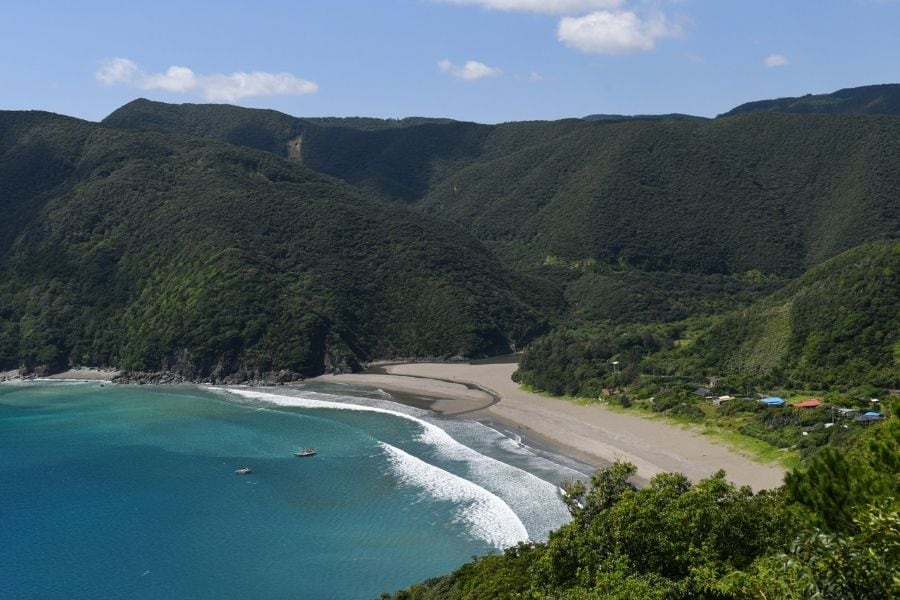In July, the beach became part of a new UNESCO World Heritage Site, a preserve of verdant peaks and mangrove forests in far southwestern Japan that is home to almost a dozen endangered species.
Two months later, the placid air was split by a new sound: the rumble of trucks and excavators preparing to strip away a large section of Katoku’s dune and bury inside of it a two-story-tall concrete wall meant to curb erosion.
The sea wall project demonstrates how not even the most precious ecological treasures can survive Japan’s construction obsession, which has long been its answer to the threat of natural disaster — and a vital source of economic stimulus and political capital, especially in rural areas.
But the plan to erect the concrete berm on the pristine beach, a vanishingly rare commodity in Japan, is not just about money or votes. It has torn the village apart as residents fight deeper forces remaking rural Japan: climate change, aging populations and the hollowing-out of small towns.
The project’s supporters — a majority of its 20 residents — say the village’s survival is at stake, as it has been lashed by fiercer storms in recent years. Opponents — a collection of surfers, organic farmers, musicians and environmentalists, many from off the island — argue a sea wall would destroy the beach and its delicate ecosystem.
Leading the opposition is Jean-Marc Takaki, 48, a half-Japanese Parisian who moved into a bungalow behind the beach last year. A nature guide and former computer programmer, Takaki began campaigning against the wall in 2015, after moving to a nearby town to be closer to nature.
The fight embodies a clash playing out in rural areas across Japan. Old-timers see their traditional livelihoods in industries like logging and construction threatened by newcomers dreaming of a pastoral existence. Villages may need new residents to bolster their eroding populations and economies, but sometimes chafe at their presence.
When Takaki first visited Katoku in 2010, it seemed like the paradise he had been seeking. “I had never seen any place like it," he said.
That has all changed. “If they finish building this thing, I don’t know what we’re going to do here."
Confronting nature with concrete
Japan’s countryside is pockmarked with construction projects like the one planned for Katoku.
The country has dammed most of its rivers and lined them with concrete. Tetrapods — giant concrete jacks built to resist erosion — are piled along every habitable inch of coastline. After the 2011 earthquake and tsunami that devastated the country’s northeast and triggered the Fukushima nuclear meltdown, planners rimmed the region with sea walls.
The projects are often logical for a country plagued by earthquakes, volcanoes, tsunamis, landslides and typhoons, said Jeremy Bricker, an associate professor at the University of Michigan who specializes in coastal engineering.
The question, he said, is “to what extent is that concrete there because of the stuff that needs to be protected and to what extent is it part of the Japanese culture?"
In some cases, concrete could be replaced with natural buffers, like supplemental sand or heavy vegetation, Bricker said. While some Japanese civil engineers are using such alternatives, he added, “Japan’s been so focused on promoting work for traditional contractors — that means casting concrete — that there hadn’t been as much emphasis on soft solutions."
The typhoons strike
Environmental engineers describe beaches as dynamic environments — growing, shrinking and shifting along with the seasons and tides. New elements like a sea wall can have unpredictable and destabilizing effects.
Rural communities are no different.
In Katoku, change came slowly, then suddenly.
For decades, residents refused government offers to armor the shore with concrete.
But in 2014, two strong typhoons washed away the beach and uprooted the pandanus trees that protected the village. The cemetery, built atop a high dune separating the village from the sea, was now perched precariously above the tattered strand.
The storms shook the villagers’ confidence in the bay’s ability to protect them.
“The waves came right up to the cemetery," said Sayoko Hajime, 73, who moved to Katoku with her husband — a native — 40 years ago. “Afterward, everyone was terrified they panicked."
After the typhoons, the village approached the prefectural government for help. Planners recommended a 1,700-foot-long concrete wall to stop the ocean from devouring the beach.
Takaki, who then lived nearby, and a handful of others objected. They recruited analysts, who concluded that the government hasn’t demonstrated the need for concrete fortifications. Those experts argued that a hard defense could accelerate the loss of sand, a phenomenon observed in nearby villages where the ocean laps against weathered concrete walls.
Further complicating matters, a river — home to endangered freshwater fish — carves a channel to the ocean, moving up and down the beach in seasonal rhythm.
The prefecture agreed to shrink the proposed wall by more than half. It would be covered in sand to protect the beach’s aesthetic, they said, and if that sand washed away, it could be replaced.
Meanwhile, Takaki’s group reinforced the dunes with new pandanus. The beach naturally recovered its pre-typhoon size.
Still, officials continue to insist a berm is necessary. In other villages, “there’s a strong sense that, when a typhoon comes, they are protected by their sea wall," explained Naruhito Kamada, the mayor of Katoku’s township, Setouchi. “And the typhoons are getting bigger."
Other options are worth exploring, said Tomohiko Wada, one of several lawyers suing to stop construction: “The villagers wanted to do something, and the prefecture said ‘concrete,’ because that’s what Japan does," he said.
Local authorities declined to comment on the lawsuit. But Japanese law does not provide for stop-work orders in such cases, and the prefecture seems intent on finishing the job before courts rule.

